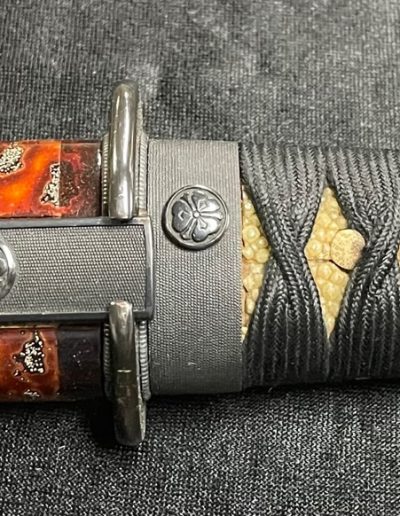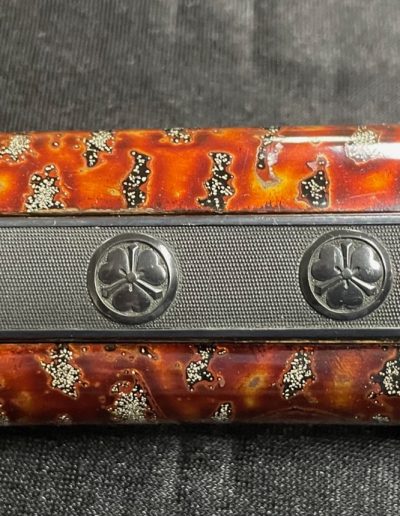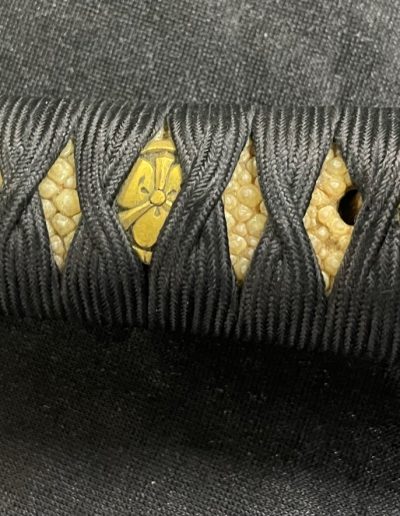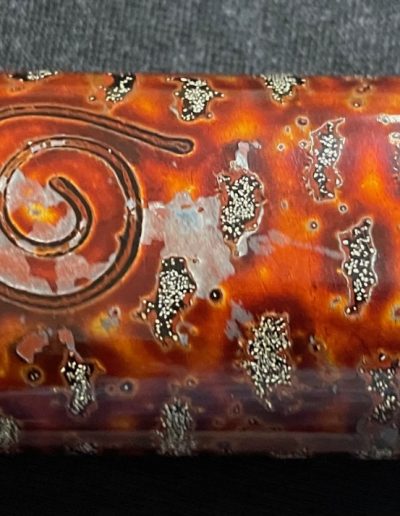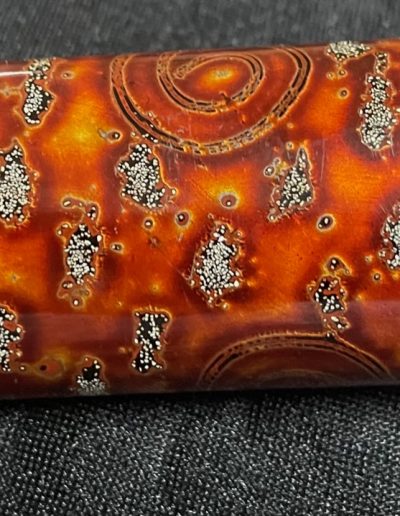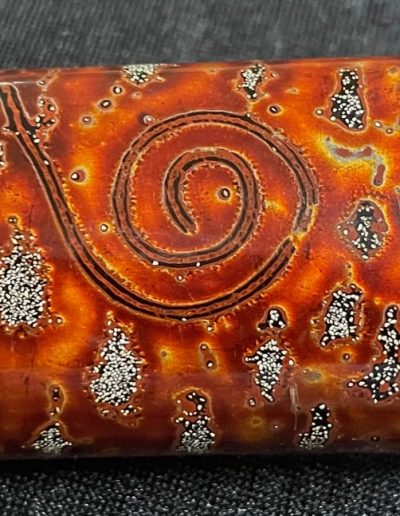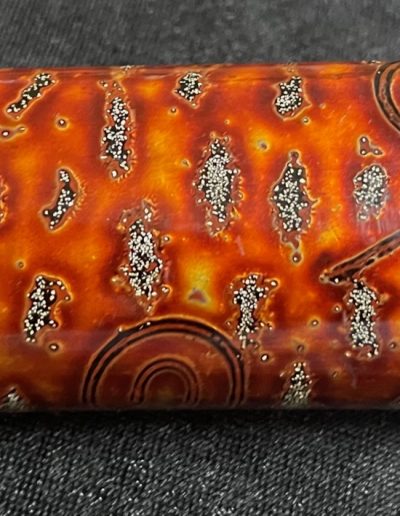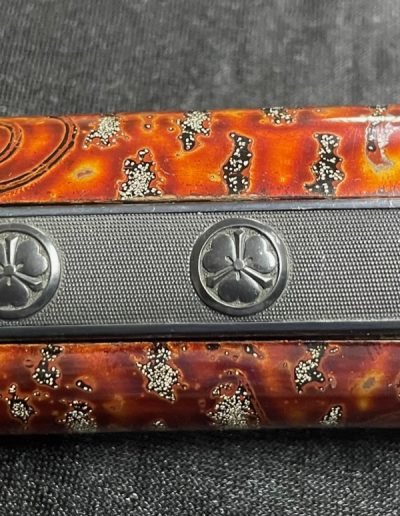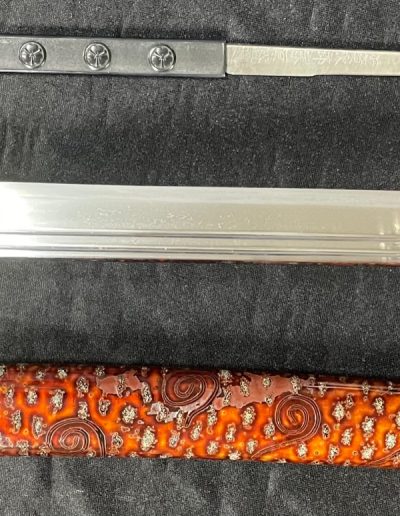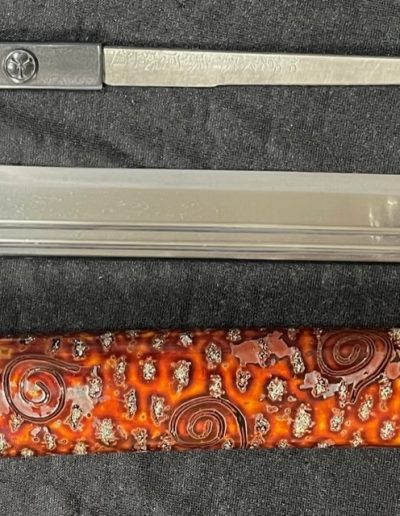Consigned
Nobukuni Nambokucho Tanto mounted in Excellent Koshirae with Shakudo fittings of Kamon set in a very fine Nanako ground,Beautifuly Lacquered Saya .Well forged Solid Blade with Suguha Hamon in full polish.
NOBUKUNI (信国), 1st gen., Kenmu (建武, 1334-1338), Yamashiro – “Nobukuni” (信国), according to tradition
the son of the Enkyō-era (延慶, 1308-1311) Ryō Hisanobu (了久信), other traditions see him as son of Kunihisa (国久)
who was Hisanobu’s younger brother, there exists also the theory that he signed first with Hisanobu and then with
Nobukuni but this is doubted, from Ryō Hisanobu we know date signatures from the third year of Tokuji (徳治, 1308)
and the third year of Enkyō (1310), the oldest extant dated Nobukuni blade is from the third year of Enbun (延文, 1358)
and is attributed to the 2nd gen., this would support the 1st generation´s assumed active period of Kenmu, Nobukuni is
listed as one of the “Three Students of Sadamune,” he takes over the Sōshū style of Sadamune (貞宗) and combines it
with Yamashiro elements, we know excellently engraved and aesthetically arranged horimono like bōhi, bōhi with futasuji-hi,
ken-maki-ryū, or bonji, the tip of his ken is pointed and looks acute and its upper part is deeper and wider cut then the
lower part, this Sōshū-style of horimono distinguishes him from the carvings of his Yamashiro colleagues, the jihada is
mokume with ji-nie, the hamon is a chū-suguha mixed with ko-midare, the bōshi follows the hamon and the tip of the bōshi often
tends towards the mune, tantō of Nobukuni are similar to that of Rai Kunimitsu (来国光) but not that many are extant, it
is said that he worked either in Kyōto´s Horikawa (堀川) or Shinanokōji (信濃小路), he is considered as founder of the
Nobukuni school but because there are no authentic signatures extant some regard the below listed 2
nd gen. as actual 1st
gen. of the school what causes some confusion in the counting of generations, jōjō-saku ◎
NOBUKUNI (信国), 2
nd gen., Enbun (延文, 1356-1361), Yamashiro – “Nobukuni” (信国), according to tradition the
son of Nobuhisa (信久) who was the son of Ryō Hisanobu (了久信), as mentioned above, some see him as actual 1st
gen. of the Nobukuni school, we know tantō with date signatures of the third year of Enbun (1358) and the fifth year of
Jōji (貞治, 1366), they have a wide mihaba and a little sori, the jigane is a somewhat standing-out itame with ji-nie, the hamon
is a suguha to slightly undulating notare in ko-nie-deki mixed with ko-gunome, that means we can see Sōshū characteristics in
his Yamashiro works, besides of that he also made sunnobi-tantō or hira-zukuri ko-wakizashi which are entirely interpreted
in the Sōshū style, they have a wide mihaba, a noticeable sori, an ō-itame with much ji-nie, chikei, and jifu, and are hardened
in a notare that is mixed with partially angular gunome or in a ko-midare with gunome in nie-deki, in addition sunagashi appear
and many blades show horimono
NOBUKUNI (信国), 3
rd gen., Shitoku (至徳, 1384-1387), Yamashiro – “Nobukuni” (信国), we know date signatures
from the fourth year of Shitoku (1387), the first year of Kōō (康応, 1389) and the third year of Meitoku (明徳, 1392),
there are tachi, hira-zukuri ko-wakizashi, and tantō extant whereas wakizashi can also be shaped as shōbu-zukuri, the jigane is
itame mixed with mokume that shows fine ji-nie, chikei, and sometimes also a bō-utsuri, the hamon is a ko-notare mixed with
gunome, ashi, kinsuji, and sunagashi, the bōshi is a slightly undulating notare-komi with a pointed ko-maru-kaeri, he too was an
excellent horimono carver




